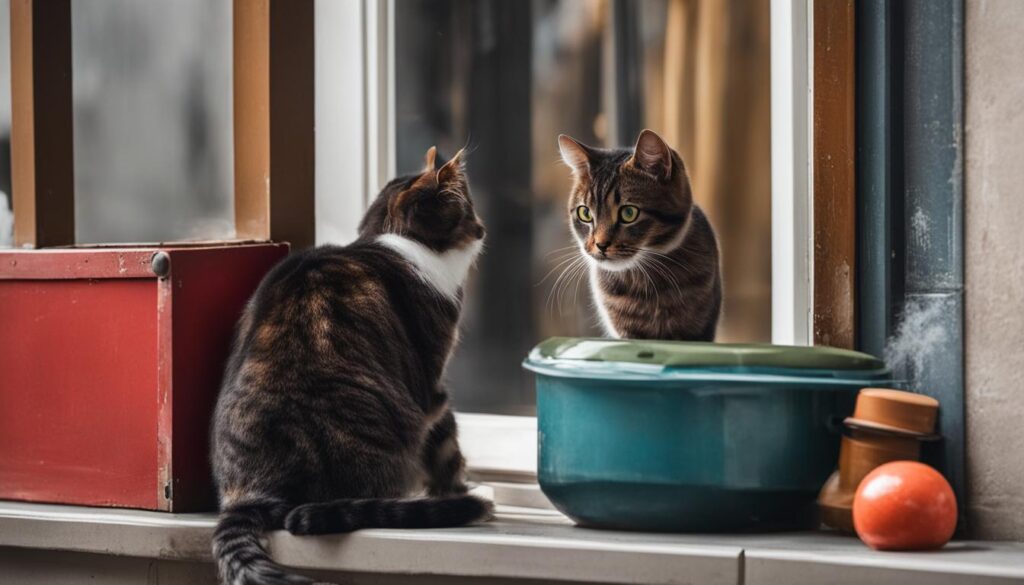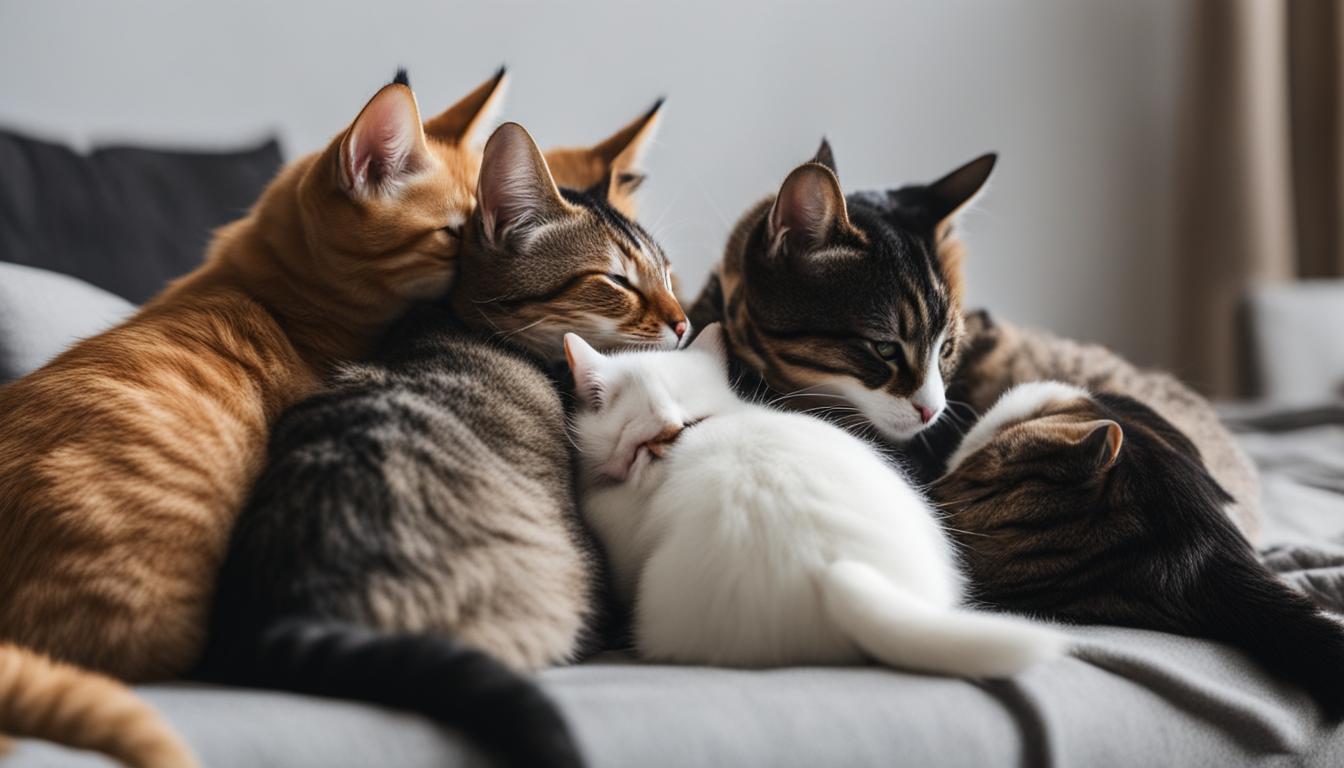Cats have always been fascinating creatures, captivating us with their independent nature and mysterious ways. But when it comes to their behavior and training, there are numerous myths that cloud our understanding. So, let’s embark on a journey to uncover the truth behind these misconceptions and explore effective behavioral therapies for our feline friends.
Key Takeaways:
- Cats’ behavior and training are often subject to misconceptions and myths.
- Understanding the reality of feline behavior modification is essential for responsible cat ownership.
- Cat behavioral therapy involves using positive reinforcement techniques and debunking training myths.
- By separating facts from fiction, we can enhance the bond with our cats and promote their overall well-being.
- Stay informed, seek professional advice, and debunk common training myths for a harmonious relationship with your feline companion.
The Truth About Cat Care Myths
When it comes to cat care, there are many myths that need to be debunked. One common misconception is that cats are low-maintenance companions who only require basic needs like food, water, litter, and a cozy place to sleep. While these are essential, cats have individual personalities and require more than just the bare necessities.
Cats are curious creatures who thrive on mental stimulation and exercise. They need opportunities to play, explore, and engage with their environment. Providing them with interactive toys, scratching posts, and climbing structures can help keep them entertained and prevent boredom. In addition, regular playtime with their owners is crucial for bonding and maintaining their overall well-being.
Just like humans, cats can also experience illness. However, unlike humans, they are masters at hiding signs of sickness. It’s important for cat owners to recognize subtle cues that may indicate illness. Changes in appetite, litter box habits, grooming behavior, or overall energy levels can be early warning signs. If you notice any unusual behaviors or have concerns about your cat’s health, it’s best to consult with a veterinarian for proper diagnosis and treatment.
The Importance of Recognizing Signs of Illness in Cats
Recognizing signs of illness in cats is crucial for their well-being. Cats are instinctively wired to hide signs of weakness or vulnerability, making it challenging for owners to detect health issues. Regular check-ups and observation of their behavior and physical appearance can help catch potential problems early on.
| Signs of Illness in Cats | What to Look For |
|---|---|
| Loss of appetite | Significant decrease in food intake or refusing to eat |
| Changes in litter box habits | Using the litter box more or less frequently, straining to urinate or defecate, blood in urine or stool |
| Changes in grooming behavior | Excessive grooming, matting of fur, unkempt appearance |
| Changes in energy levels | Lethargy, decreased activity, hiding more often than usual |
| Behavioral changes | Aggression, excessive vocalization, hiding, increased or decreased social interaction |
By understanding the reality of cat care and recognizing the signs of illness, cat owners can provide the best possible care for their furry companions. Remember, cats are not just low-maintenance pets, but complex creatures who deserve love, attention, and proactive healthcare.
Debunking Common Training Myths
When it comes to training cats, there are many misconceptions that can hinder the progress of both the cat and the owner. One common myth is that cats cannot be trained at all. However, this couldn’t be further from the truth. Cats are capable of learning and can be trained using positive reinforcement techniques such as clicker training.
Clicker training for cats involves using a small handheld device that makes a distinct clicking sound. The clicker is paired with a reward, usually a tasty treat, to reinforce desired behaviors. This method helps cats associate the sound of the clicker with receiving a reward, making it easier to shape their behavior. Contrary to the misconception that cats are untrainable, clicker training has been proven effective in various studies.
Positive reinforcement training is another effective approach when training cats. This method involves rewarding desired behaviors with praise, affection, or treats. By focusing on rewarding what the cat does right instead of punishing what it does wrong, positive reinforcement creates a positive learning environment and strengthens the bond between the cat and its owner.
“Training a cat is all about understanding their motivations and using positive reinforcement to encourage desired behaviors. It’s not about dominating or forcing them to do something they don’t want to do.” – Dr. Jane Thompson, Feline Behavior Specialist
Common Cat Training Myths
- Myth: Cats are untrainable. Reality: Cats can be trained using positive reinforcement techniques.
- Myth: Punishment is an effective training method. Reality: Positive reinforcement is more effective and creates a positive learning environment.
- Myth: Cats should be trained using dominance and force. Reality: Training should be based on understanding the cat’s motivations and using positive reinforcement.
- Myth: Cats only do what they want to do. Reality: Cats can learn desired behaviors through proper training and motivation.

| Training Myth | Reality |
|---|---|
| Myth: Cats are untrainable. | Reality: Cats can be trained using positive reinforcement techniques such as clicker training. |
| Myth: Punishment is an effective training method. | Reality: Positive reinforcement is more effective and creates a positive learning environment. |
| Myth: Cats should be trained using dominance and force. | Reality: Training should be based on understanding the cat’s motivations and using positive reinforcement. |
| Myth: Cats only do what they want to do. | Reality: Cats can learn desired behaviors through proper training and motivation. |
These myths are often perpetuated by a lack of understanding of feline behavior and training methods. By debunking these myths and educating cat owners about effective training techniques, we can help create a harmonious and well-trained feline companionship.
Overcoming Training Challenges with Cats
Training cats can be a rewarding experience, but it also comes with its fair share of challenges. Whether you’re working with a mischievous kitten or an older cat set in their ways, understanding the basics of cat obedience training is essential for success.
Behavioral Training for Kittens
When it comes to training kittens, patience is key. They are naturally curious and full of energy, which can make it difficult for them to focus during training sessions. It’s important to keep training sessions short and engaging, using positive reinforcement techniques such as treats or toys to reward desired behaviors.
One common challenge with training kittens is their tendency to bite or scratch. This behavior is natural for them as they explore their environment and develop their hunting instincts. To address this challenge, it’s important to provide appropriate outlets for their energy and play, such as interactive toys or scratching posts. Additionally, teaching gentle play and redirecting their attention when they become too rough can help curb unwanted biting and scratching.
Cat Obedience Training Basics
Cat obedience training is all about establishing a line of communication with your feline companion and teaching them basic commands. The key to success is consistency and positive reinforcement. Cats respond well to rewards, so using treats or praise to reinforce desired behaviors can be highly effective.
Some common commands to teach your cat include “sit,” “stay,” and “come.” Start by breaking down the command into small steps and rewarding your cat at each stage of the learning process. It’s important to be patient and understanding, as cats may take longer to learn commands compared to dogs. With practice and repetition, your cat will eventually understand and respond to your cues.
Remember, training should always be a positive experience for both you and your cat. Avoid punishment-based techniques, as they can lead to fear and anxiety in cats. Instead, focus on building a strong bond through trust and positive reinforcement.

| Training Challenge | Solution |
|---|---|
| Difficulty focusing during training sessions | Keep sessions short and engaging. Use treats or toys as rewards. |
| Biting and scratching during playtime | Provide appropriate outlets for play, such as interactive toys or scratching posts. Teach gentle play and redirect attention when behavior becomes rough. |
| Establishing basic commands | Use positive reinforcement techniques and be consistent with training. Break down commands into small steps and reward progress. |
| Avoiding punishment-based techniques | Focus on building trust and a positive bond with your cat through rewards and understanding. |
By understanding the unique challenges of training cats, especially kittens, and employing positive reinforcement techniques, you can overcome these obstacles and create a positive training experience for your furry friend. Remember to be patient, consistent, and always prioritize your cat’s well-being.
The Reality of Cat Behavior Modification
When it comes to cat behavior, owners often encounter challenges that require behavior modification techniques. Whether it’s dealing with aggression, anxiety, or destructive behavior, understanding how to overcome these issues is essential for creating a harmonious environment for both cats and their human companions.
One effective approach to cat behavior modification is using positive reinforcement techniques. By rewarding desirable behaviors with treats, praise, or playtime, cats can learn to associate those behaviors with positive outcomes. This method not only helps in overcoming behavioral issues, but also strengthens the bond between the cat and the owner.
Another key aspect of cat behavior modification is understanding the underlying motivations behind certain behaviors. Cats may exhibit destructive behavior as a result of boredom or lack of mental stimulation. Providing environmental enrichment, such as interactive toys and scratching posts, can redirect their energy and prevent unwanted behaviors.
It’s important to note that behavior modification takes time and patience. Consistency is key in reinforcing positive behaviors and redirecting negative ones. Seeking guidance from a professional, such as a feline behaviorist or veterinarian, can provide valuable insights and tailored strategies to address specific behavioral issues.

Table: Overview of Cat Behavior Modification Techniques
| Technique | Description |
|---|---|
| Positive Reinforcement | Rewarding desired behaviors with treats, praise, or playtime to reinforce positive associations. |
| Environmental Enrichment | Providing interactive toys, scratching posts, and other stimuli to prevent boredom and redirect destructive behavior. |
| Counterconditioning | Gradually exposing cats to triggers that elicit unwanted behavior, while simultaneously offering positive experiences or rewards to change their emotional response. |
| Desensitization | Gradually exposing cats to fear-inducing stimuli in a controlled and positive manner to reduce their fear or anxiety. |
| Redirecting Techniques | Redirecting cats’ attention and energy towards more appropriate behaviors, providing alternative outlets for their natural instincts. |
Remember, every cat is unique, and what works for one may not work for another. Patience, consistency, and understanding are key components of successful cat behavior modification. By utilizing positive reinforcement techniques and seeking professional guidance when needed, owners can overcome behavioral issues and create a happier, healthier environment for their feline companions.
Training Indoor and Outdoor Cats
When it comes to caring for our feline friends, there are different considerations to keep in mind for indoor and outdoor cats. While keeping cats indoors can protect them from various risks, it’s important to provide them with environmental enrichment to prevent boredom and promote their well-being.
Indoor cats may not have the same opportunities for exploration and physical exercise as their outdoor counterparts, so it’s essential to create an engaging environment for them. This can include providing scratching posts, interactive toys, and vertical spaces for climbing. Additionally, setting aside time each day to play with your indoor cat can help stimulate their minds and keep them mentally and physically active.
However, even indoor cats are not entirely immune to certain risks. They can still be exposed to diseases and parasites, especially if they have contact with other animals or if they venture outdoors. Regular veterinary check-ups are crucial to monitor their health and ensure they receive necessary vaccinations and preventive treatments. By staying on top of their healthcare needs, we can give our indoor cats the best chance at a long and healthy life.
Outdoor cats, on the other hand, have more freedom to explore their surroundings and engage in natural behaviors. However, this freedom also comes with additional risks. Outdoor cats are more likely to encounter hazards such as traffic accidents, encounters with other animals, and exposure to contagious diseases. It’s important to provide them with a safe and secure outdoor space, such as an enclosed garden or catio, to minimize these risks while still allowing them to enjoy the outdoors.
| Indoor Cats | Outdoor Cats | |
|---|---|---|
| Risks | Lower risk of accidents and exposure to diseases | Higher risk of accidents, encounters with other animals, exposure to diseases |
| Environmental Enrichment | Provide scratching posts, interactive toys, vertical spaces | Safe and secure outdoor space, such as an enclosed garden or catio |
| Healthcare | Regular veterinary check-ups, vaccinations, preventive treatments | Regular veterinary check-ups, vaccinations, preventive treatments |
The Importance of Responsible Ownership
Whether you have an indoor or outdoor cat, responsible ownership is key to ensuring their well-being. This includes providing them with a safe and enriching environment, regular veterinary care, and attention to their individual needs. By understanding the specific considerations for both indoor and outdoor cats, we can create a lifestyle that promotes their happiness and health.
Remember, cats are unique individuals with their own preferences and needs. It’s important to observe and understand their behavior, and make adjustments to their care accordingly. By doing so, we can create a nurturing and fulfilling environment for our furry companions.

Promoting a Healthy Lifestyle for Cats
As cat owners, we want to ensure that our feline companions lead a healthy and happy life. This means providing them with proper nutrition, regular exercise, and regular veterinary check-ups. However, there are some common myths surrounding cat nutrition that we need to debunk in order to make informed choices for our cats’ well-being.
Cat Nutrition Myths:
- Myth 1: Cats should only eat dry food. The truth is that cats are obligate carnivores and require a diet rich in animal protein. While dry food can be convenient, it’s important to also incorporate wet food or a balanced raw diet to meet their nutritional needs.
- Myth 2: Cats should drink milk. While it’s true that cats love the taste of milk, most adult cats are lactose intolerant and cannot properly digest it. It’s best to provide them with fresh water instead.
- Myth 3: Cats should eat a vegetarian or vegan diet. Cats have specific nutritional requirements that can only be met through animal-based proteins. Feeding them a vegetarian or vegan diet can lead to nutrient deficiencies and health issues.
Exercise plays a crucial role in maintaining a healthy weight and preventing obesity in cats. Indoor cats, in particular, may have limited opportunities for exercise. To keep them active and engaged, provide interactive toys, scratching posts, and vertical spaces for climbing. Regular play sessions with your cat using toys that encourage them to run, jump, and pounce are also beneficial.
Regular veterinary check-ups:
- Schedule regular veterinary check-ups for your cat to monitor their overall health and detect any potential issues early on. Your veterinarian can provide guidance on vaccinations, parasite prevention, dental care, and tailored advice based on your cat’s specific needs.
- During check-ups, your veterinarian will perform a thorough examination, including checking your cat’s weight, dental health, and listening to their heart and lungs. They may also recommend blood tests or additional screenings to assess your cat’s internal health.
- Remember to discuss any concerns or changes in your cat’s behavior or appetite with your veterinarian. They are there to help ensure your cat’s well-being and address any questions or issues you may have.
By dispelling cat nutrition myths, providing opportunities for exercise, and scheduling regular veterinary check-ups, we can promote a healthy lifestyle for our feline companions. Remember, a well-balanced diet, regular physical activity, and proper medical care are key to keeping our cats happy and thriving.
| Myth | Reality |
|---|---|
| Cats should only eat dry food. | Cats are obligate carnivores and require a diet rich in animal protein. Incorporate wet food or a balanced raw diet. |
| Cats should drink milk. | Most adult cats are lactose intolerant. Provide them with fresh water instead. |
| Cats should eat a vegetarian or vegan diet. | Cats require animal-based proteins. Feeding them a vegetarian or vegan diet can lead to nutrient deficiencies. |
Conclusion
Cat behavioral therapy and training is an essential part of responsible cat ownership. By separating myths from reality and utilizing effective training techniques, owners can strengthen the bond with their feline companions and promote their overall well-being.
Throughout this article, we have debunked common misconceptions about cat behavior and training. We have learned that cats are capable of learning and can be trained using positive reinforcement techniques, such as clicker training. Additionally, we have explored the challenges involved in training cats, especially when dealing with kittens, and discovered how to overcome them through behavioral training.
To ensure success in cat training, it is important to understand the reality of cat behavior modification. By using positive reinforcement techniques and addressing the underlying motivations behind certain behaviors, owners can effectively modify their cat’s behavior and create a harmonious environment.
As responsible cat owners, it is crucial to stay informed about the latest research and seek professional advice when needed. This will help us navigate the intricacies of cat training and provide the best possible care for our feline friends. By investing time and effort into behavioral therapy and training, we can create a happy and fulfilling relationship with our cats, promoting their overall well-being and enriching both their lives and ours.
FAQ
Can cats be trained?
Yes, cats are capable of learning and can be trained using positive reinforcement techniques such as clicker training.
Are cats low-maintenance pets?
While cats may not require as much attention as some other pets, they have individual personalities and need more than just basic resources. They require opportunities for exercise, mental stimulation, and a safe environment.
How can I recognize signs of illness in my cat?
Cats are masters at hiding signs of illness, so it’s important for owners to be vigilant and recognize subtle cues such as changes in appetite, litter box habits, or behavior.
What is cat behavior modification?
Cat behavior modification involves using positive reinforcement techniques and understanding the underlying motivations behind certain behaviors to effectively modify a cat’s behavior.
Is it possible to train outdoor cats?
Yes, outdoor cats can still be trained using positive reinforcement techniques. However, it’s important to provide them with environmental enrichment and be aware of the risks they may face outside.
How can I promote a healthy lifestyle for my cat?
You can promote a healthy lifestyle for your cat by providing them with a balanced diet, opportunities for exercise, and scheduling regular veterinary check-ups.
What should I know about indoor cat care?
Indoor cats require environmental enrichment to prevent boredom. Additionally, they are still at risk for diseases and parasites, so regular veterinary care is important.





